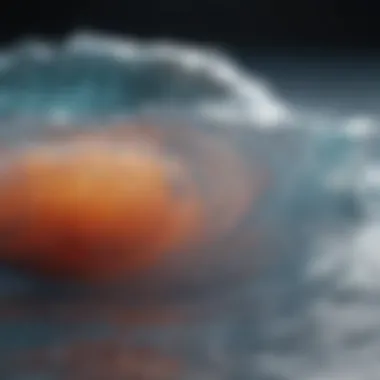Understanding Gentle Wave Endodontics: Principles and Applications


Intro
The concept of Gentle Wave Endo has gained traction in various scientific and clinical discussions. Its significance lies in the innovative approach it brings to endodontics. This method seeks to enhance the cleaning and shaping of root canals with a focus on effectiveness and minimal invasiveness. By integrating newer techniques and materials, Gentle Wave Endo aims to address common challenges faced in traditional endodontic treatments.
Research Overview
Summary of Key Findings
Research around Gentle Wave Endo highlights several core findings:
- Effectiveness: Multiple studies show that the Gentle Wave technique offers superior cleaning of the root canal systems compared to conventional methods.
- Reduced chair time: Many clinicians report shorter treatment durations, benefiting both patient comfort and clinical efficiency.
- Preservation of tooth structure: This approach minimizes the loss of healthy tooth tissue, which is crucial for long-term tooth integrity.
Methodologies Employed
The methodologies in researching Gentle Wave Endo typically involve:
- Experimental studies: These are conducted in laboratory settings to assess the cleaning efficiency of the Gentle Wave system against traditional techniques.
- Clinical trials: These trials involve a cohort of patients undergoing treatment. Their outcomes, including recovery times and success rates, are compared.
- Systematic reviews: Researchers often compile data from various studies to synthesize findings and establish best practices.
In-Depth Analysis
Detailed Examination of Results
Further examination of research findings showcases specific metrics. For instance, studies employing micro-computed tomography (micro-CT) have revealed significant differences in debris removal. The Gentle Wave Endo method consistently outperformed traditional approaches in achieving cleaner canals.
Comparison with Previous Studies
When comparing Gentle Wave Endo to prior methodologies, it reveals substantial advances. Earlier studies suggested that existing techniques such as rotary instruments were effective yet often caused dentin loss. Gentle Wave Endo demonstrates a marked improvement by using sound waves for cleaning, thereby preserving dentin and enhancing overall dental health.
"The introduction of the Gentle Wave system represents a paradigm shift in endodontics, merging technology and biology to improve patient outcomes."
In summary, the literature supports a positive trajectory for Gentle Wave Endo, indicating a shift towards more efficient and less invasive endodontic treatments. The ongoing research continues to pave the way for future developments in the field.
For more detailed overviews, consider exploring sources like Wikipedia, Britannica. Also, platforms like Reddit offer community insights and discussions about Gentle Wave Endo.
Intro to Gentle Wave Endo
Understanding Gentle Wave Endo represents a critical advancement in therapeutic and diagnostic methodologies. This article aims to explore its foundational principles, significant applications, and the scientific rationale that supports its growing relevance in diverse fields. The discussion will highlight how this innovative approach not only streamlines conventional processes but also opens new pathways for research and practical applications, making it invaluable for students, researchers, and professionals alike.
Definition of Gentle Wave Endo
Gentle Wave Endo is defined as a novel endodontic treatment modality that utilizes sound wave technology to facilitate the cleaning and shaping of root canals. This method leverages acoustic energy to enhance irrigation and disinfection procedures. The efficiency of Gentle Wave Endo stems from its ability to reach areas traditionally inaccessible during standard endodontic practices. By using a combination of hydrodynamic and acoustic principles, it effectively disrupts biofilms and removes debris. This technique promotes better outcomes in root canal treatments, aiming to increase success rates and patient comfort.
Historical Context
The development of Gentle Wave Endo is rooted in the broader evolution of endodontics and the integration of technology in dental practices. Historically, root canal treatments relied heavily on mechanical instrumentation and chemical irrigants. However, these traditional methods often fell short in eliminating complex biofilms and ensuring thorough disinfection.


In the early 2000s, researchers began to explore how sound waves could be harnessed to improve endodontic procedures. Initial studies indicated that acoustic cavitation—a phenomenon driven by sound waves—could effectively disrupt microorganisms and facilitate better cleansing of root canals. This research laid the groundwork for the Gentle Wave system, which officially emerged in the dental community in the late 2010s. The introduction of this technology marked a significant shift, where clinicians could provide more effective and less invasive treatments, which ultimately improves patient experience and clinical outcomes.
Through the years, Gentle Wave Endo has continued to gain recognition and acceptance among dental professionals, driven by ongoing clinical studies and evolving techniques. Today, it stands as a testament to how innovation fuels progress in dental treatments and patient care.
Scientific Foundations
The section on Scientific Foundations is essential to understanding Gentle Wave Endo. This topic illustrates how the principles of physics and mathematics converge to form a powerful methodology. By exploring these foundations, readers gain insight into why Gentle Wave Endo stands as a significant innovation in its field. These foundations inform both the theoretical framework and practical applications of this technique.
Physics of Wave Motion
The physics of wave motion is critical to the operation of Gentle Wave Endo. Waves are disturbances that transfer energy through a medium. Understanding wave mechanics helps explain how gentle waves can effectively penetrate through various materials without causing damage. The behavior of waves, including their speed, wavelength, and amplitude, plays a vital role in the efficacy of this approach.
A fundamental principle in wave motion is the superposition of waves. When multiple waves overlap, they can enhance or diminish each other. This concept is utilized in Gentle Wave Endo to create a more uniform energy distribution. By controlling the interaction of waves, practitioners can achieve more precise outcomes compared to traditional methods.
Underlying Mathematical Models
Mathematics is the backbone of wave motion analysis. The underlying mathematical models used in Gentle Wave Endo provide the means to predict wave behavior under various conditions. Differential equations, particularly the wave equation, are crucial for this analysis. Using these models, one can simulate wave interactions within different media.
Additionally, complex numbers are often used in this context. They facilitate calculations involving phase shifts and other wave characteristics. These mathematical tools allow researchers to develop protocols that maximize efficacy while minimizing risks.
Exploring these models helps stakeholders identify optimal conditions for wave application, thereby enhancing both safety and effectiveness in practical settings.
Comparison with Traditional Methods
Comparing Gentle Wave Endo with traditional methods unveils its advantages and application potential. Traditional methods often rely on more invasive techniques, which may lead to additional complications during procedures. These methods can cause damage to surrounding tissues or materials, prolong recovery times, and increase discomfort for patients.
In contrast, Gentle Wave Endo offers a minimally invasive alternative. Its design prioritizes patient safety and comfort while effectively achieving desired outcomes. Many studies indicate that this technique can result in quicker recovery times and lower rates of complications, attributes that are paramount in medical settings.
Applications of Gentle Wave Endo
The applications of Gentle Wave Endo are both diverse and significant. This innovative approach offers solutions in various fields, particularly in medicine and industry. Understanding these applications helps in grasping the overall impact of this technique on clinical practices and industrial processes. Gentle Wave Endo stands out due to its ability to significantly enhance efficiency and safety across multiple domains, making it an essential area of study and implementation.
Medical Applications
Diagnostic Uses
The diagnostic uses of Gentle Wave Endo play a critical role in modern medicine. This aspect enhances imaging techniques, allowing for clearer and more accurate visuals of internal structures. The key characteristic of reforming diagnostic imaging with wave motion technology is its improved sensitivity in detecting anomalies. This increased precision is particularly beneficial for identifying early stages of diseases, which can lead to better patient outcomes.
One unique feature of these diagnostic methods is the capability to visualize areas that traditional methods may miss. For instance, Gentle Wave Endo can unveil subtle abnormalities in soft tissues and vascular structures. The advantages of this method include a non-invasive approach that reduces the need for exploratory surgeries. However, it may also have disadvantages such as the need for specialized training for optimal implementation.
Therapeutic Applications
In therapeutic applications, Gentle Wave Endo demonstrates significant benefits in managing various medical conditions. This application is crucial for treatment methodologies that require precision and minimally invasive procedures. The key characteristic of therapeutic Gentle Wave Endo is its ability to deliver targeted treatment without affecting surrounding tissues. This aspect makes it a popular choice within various healthcare applications.
A unique feature of this therapeutic approach is the use of wave actions to facilitate healing. By utilizing specific frequency ranges, the technique helps in promoting tissue regeneration and reducing inflammation. Although this has advantages in enhancing recovery times and improving patient comfort, it may also face challenges such as inconsistency in results based on patient variability.


Industrial Applications
Material Testing
Material testing is another critical area where Gentle Wave Endo proves its utility. This application focuses on evaluating the integrity and quality of materials in various industries. A primary advantage of utilizing wave motion technology in material testing is its ability to detect flaws without damaging the material itself. This makes it a favorable choice for industries where material reliability is paramount.
The unique feature of Gentle Wave Endo in this context is advanced sensors that can gauge different material responses to wave stimuli. This allows for comprehensive evaluations that traditional testing methods may overlook, ensuring higher safety standards in product development. However, one disadvantage could be the initial investment in technology, which may be costly for smaller operations.
Quality Control
Quality control is fundamental in industrial processes, and Gentle Wave Endo offers enhanced methodologies. This application significantly contributes to maintaining standards and compliance within production lines. The key characteristic of this approach is its real-time monitoring capabilities, which ensure that variations in material properties are immediately flagged.
One unique feature in quality control applications is the integration of Gentle Wave Endo within automated systems. This ensures ongoing integrity checks without interrupting production cycles. The advantages include increased efficiency and reduced waste. On the other hand, the system’s reliance on technology may introduce challenges related to system malfunctions or inaccuracies in data interpretation.
In summary, the applications of Gentle Wave Endo reflect its versatility and significance across medical and industrial fields. This technique not only improves diagnostic and therapeutic processes but also enhances material testing and quality control.
Recent Research and Developments
Recent research and developments in Gentle Wave Endo have unveiled its expanding role in various fields. The advancements in this area highlight its potential for reshaping existing methodologies. Understanding these developments is vital. It enables researchers and practitioners to stay at the forefront of the technique, enhancing its application and effectiveness.
Notable Studies
Several studies have emerged, contributing to the body of knowledge surrounding Gentle Wave Endo. One significant research project conducted by researchers at the University of Cambridge focused on evaluating the efficacy of Gentle Wave Endo in improving diagnostic accuracy. The findings indicated that this method demonstrated a clear advantage over traditional imaging processes.
Another prominent study from the University of Pennsylvania investigated the therapeutic applications of Gentle Wave Endo in real-time monitoring of patients. The results showed that this approach could lead to quicker diagnostic procedures and improved patient outcomes, indicating a shift towards using wave motion technology in healthcare.
Furthermore, a collaborative project involving multiple institutions analyzed the implementation of Gentle Wave Endo in industrial settings. The study revealed substantial improvements in material testing accuracy, paving the way for new quality control measures. These findings underscore the versatility and effectiveness of Gentle Wave Endo across various applications, confirming its growing relevance.
Innovative Techniques
The landscape of Gentle Wave Endo is continuously evolving. Innovative techniques are on the rise, pushing the boundaries of what is possible. One major development involves the integration of machine learning algorithms. Researchers have started to apply these algorithms to analyze wave data more efficiently. This integration allows for enhanced predictive analytics capabilities in diagnostic scenarios.
In addition, advancements in sensor technology have led to the development of more sensitive and precise devices for capturing wave motion. These devices offer better accuracy in readings, which is crucial for both medical and industrial applications.
Moreover, recent workshops and conferences have highlighted the importance of cross-disciplinary approaches. Professionals from engineering, healthcare, and data science are collaborating to optimize Gentle Wave Endo further, fostering an environment for innovative solutions.
Continued exploration of these innovative techniques will likely lead to breakthroughs, cementing Gentle Wave Endo as a pivotal technique in various fields.
Challenges and Limitations
Understanding the challenges and limitations of Gentle Wave Endo is crucial for its successful implementation and further development. This area of study not only sheds light on potential roadblocks but also provides insights that can help optimize the methodology. Acknowledging these challenges allows researchers and practitioners to devise strategies that can mitigate risks and improve the efficacy of the technique. Moreover, it encourages ethical dialogue around the use of such advanced technologies, ensuring a responsible approach moving forward.
Technical Limitations
Technical limitations within Gentle Wave Endo can significantly impact the performance and adaptability of the technique. One of the foremost challenges is the precision of wave generation. Any variation in wave frequency or amplitude can lead to inconsistent results. This means that achieving reliable diagnostics or therapeutic outcomes becomes a complex task. Furthermore, the equipment requirements for Gentle Wave Endo can be demanding. High-quality devices capable of generating the necessary wave forms are not universally available. Therefore, accessibility remains a concern, especially in underfunded health systems. Additionally, there is a need for ongoing training and support to ensure that practitioners can operate these sophisticated tools effectively. The learning curve can be steep, creating a barrier to widespread adoption.


Ethical Considerations
Ethical considerations are paramount when addressing Gentle Wave Endo's challenges. As medical and industrial applications expand, it raises questions about patient safety and treatment efficacy. For example, the potential for misuse or over-reliance on technology in lieu of traditional methods poses ethical dilemmas. Ensuring that treatments based on Gentle Wave Endo adhere to established medical standards is essential for maintaining trust within the healthcare community. Furthermore, there is the concern regarding informed consent. Patients must be fully aware of the implications and potential risks associated with new technologies before undergoing procedures. Equally, the environmental impact of the materials and processes involved in Gentle Wave Endo should not be overlooked. Research must focus on minimizing negative externalities to ensure sustainable practices in its application.
"Understanding the limitations of a technique like Gentle Wave Endo not only paves the way for improvements but also ensures that ethical practices are upheld across its various applications."
In summary, while Gentle Wave Endo offers groundbreaking possibilities in medicine and industry, addressing its challenges is vital. Technical limitations must be acknowledged and resolved to promote better outcomes, while ethical considerations ensure responsible usage of the technology.
Future Directions in Research
Future directions in research surrounding Gentle Wave Endo hold substantial promise for both scientific advancement and practical applications across various fields. This section focuses on two major areas: Emerging Trends and Potential for Innovation. Understanding these aspects is essential for researchers and professionals who aim to stay at the forefront of developments in this innovative domain. Research efforts may lead to improved techniques, enhanced efficacy, and broader applications.
Emerging Trends
Recent studies indicate a shift toward increased integration of technology in Gentle Wave Endo practices. This not only includes advancements in wave generation but also the development of sophisticated computational models. More specifically:
- Real-time monitoring systems: These systems use sensors to provide immediate feedback on the wave motion, allowing for adjustments that enhance treatment precision.
- Machine Learning Applications: Data analytics, through machine learning algorithms, has the ability to predict outcomes based on previous treatment data. This provides valuable insights for practitioners.
- Interdisciplinary Collaboration: Researchers from different fields, including physics, engineering, and medicine, are beginning to collaborate, leading to richer research outcomes.
These trends collectively suggest a more streamlined approach to the implementation of Gentle Wave Endo, reducing barriers in clinical practices and enhancing patient outcomes.
Potential for Innovation
The potential for innovation within Gentle Wave Endo is significant. As foundational research continues to evolve, several key areas are emerging where innovation can occur:
- New Materials: Research into wave-responsive materials that can enhance the effectiveness of wave propagation.
- Customization of Treatment: Development of personalized treatment plans that tailor wave parameters to individual patient needs, potentially improving healing and recovery rates.
- Expansion Beyond Current Applications: Investigating novel applications of Gentle Wave Endo in unexplored fields such as environmental monitoring or industrial non-destructive testing.
As the landscape of Gentle Wave Endo evolves, the implications of these innovations could be transformative, shifting the way practitioners approach challenges faced in medical and industrial applications.
In summary, the future directions in research highlight the importance of adapting to new trends while harnessing potential innovations. Engaging with these developments ensures that Gentle Wave Endo remains relevant and effective in addressing current and future challenges.
The End
The conclusion of this article encapsulates the essence and significance of the Gentle Wave Endo concept within both medical and industrial contexts. It ties together the complex threads discussed throughout the sections and highlights the benefits this innovative approach offers.
Summary of Key Insights
Gentle Wave Endo showcases remarkable potential in various fields. The careful examination of wave motion principles illustrates how these theories can be practically applied. Key insights from this article include:
- Diverse Applications: From diagnostics to therapeutic uses in medicine, and from material testing to quality control in industry, the breadth of application is substantial.
- Scientific Backing: The underlying physics and mathematical models provide a solid foundation for its efficacy.
- Comparative Advantage: When compared to traditional methods, Gentle Wave Endo presents improvements in efficiency and effectiveness, reducing time and enhancing results.
- Critical Research Findings: Notable recent studies offer new perspectives and validate the technology for wider usage.
These benefits illuminate the relevance of Gentle Wave Endo, establishing a clear link between theoretical framework and practical outcomes.
Final Thoughts
The exploration of Gentle Wave Endo is not merely an academic exercise; it represents a crucial juncture for future advancements. As researchers and practitioners delve deeper into this area, the potential for innovation is enormous.
The evolving landscape of Gentle Wave Endo invites continued exploration. There are challenges and limitations; however, the possibilities for addressing these shortcomings through emerging techniques are encouraging. Ultimately, this article serves as an invitation to engage with Gentle Wave Endo further, inspiring students, researchers, and professionals to contribute to this vibrant and evolving field.
"Science knows no country, because knowledge belongs to humanity, and is the torch which illuminates the world." - Louis Pasteur
It is clear that as we continue to comprehend and apply the principles of Gentle Wave Endo, we unveil new horizons in science and industry, aligning with the advancements in technology and enhancing human health and productivity.















